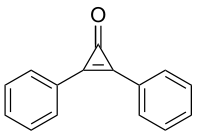Diphenylcyclopropenone
Diphenylcyclopropenone (diphencyprone) is a topically administered experimental drug intended for treating alopecia areata and alopecia totalis.[1] Topical immunotherapy using diphenylcyclopropenone may also be an effective treatment option for recalcitrant warts.[2] It is not approved by either the Food and Drug Administration or the European Medicines Agency.[3]
 | |
| Names | |
|---|---|
| IUPAC name
2,3-Diphenylcycloprop-2-en-1-one | |
| Other names
Diphencyprone, DPCP, DPC | |
| Identifiers | |
CAS Number |
|
3D model (JSmol) |
|
| ChemSpider | |
| ECHA InfoCard | 100.011.772 |
PubChem CID |
|
| UNII | |
CompTox Dashboard (EPA) |
|
InChI
| |
SMILES
| |
| Properties | |
Chemical formula |
C15H10O |
| Molar mass | 206.244 g·mol−1 |
Except where otherwise noted, data are given for materials in their standard state (at 25 °C [77 °F], 100 kPa). | |
| Infobox references | |
Mechanism of action
Diphenylcyclopropenone triggers an immune response that is thought to oppose the action of the autoreactive cells that otherwise cause hair loss.[4] One hypothesis is that in response to DPCP treatment, the body will attempt to downregulate inflammation through a variety of pathways, resulting in a downregulation of the autoimmune response at the hair follicle. This autoinflammatory reaction would otherwise destroy body's hair follicles.[3]
Studies
A study of 41 alopecia areata patients showed significant hair regrowth in 40% at 6 months, being sustained in two thirds of these after a 12-month-follow up-period.[5]
In a 2002 study for the treatment of warts, the responders consisted of 135 individuals (87.7%) that had complete clearance of warts. Reported adverse effects were local and included with pruritus (itching) (15.6%), with blistering (7.1%), and with eczematous reactions (eczema)(14.2%). The majority of the patients tolerated the treatment very well. One patient developed local impetigo (minor infection). Patients had an average of 5 treatments over a 6-month period.[2]
Chemical properties
The chemical properties of diphenylcyclopropenone are dominated by the strong polarization of the carbonyl group, which gives a partial positive charge with aromatic stabilization on the cyclopropene ring and a partial negative charge on oxygen. Furthermore, the phenyl groups stabilize the partial positive charge in the ring through resonance.
Diphenylcyclopropenone reacts with oxalyl chloride to give 1,1-dichloro-2,3-diphenylcyclopropene, which is a reagent for the activation of carboxylic acids:[6]
See also
- Benzophenone
- Cyclopropenone
References
- Singh G, Lavanya M (January 2010). "Topical immunotherapy in alopecia areata". International Journal of Trichology. 2 (1): 36–9. doi:10.4103/0974-7753.66911. PMC 3002409. PMID 21188022.
- Upitis JA, Krol A (2002). "The use of diphenylcyclopropenone in the treatment of recalcitrant warts". Journal of Cutaneous Medicine and Surgery. 6 (3): 214–7. doi:10.1007/s10227-001-0050-9. PMID 11951129.
- Bulock KG, Cardia JP, Pavco PA, Levis WR (November 2015). "Diphencyprone Treatment of Alopecia Areata: Postulated Mechanism of Action and Prospects for Therapeutic Synergy with RNA Interference". The Journal of Investigative Dermatology. Symposium Proceedings. 17 (2): 16–8. doi:10.1038/jidsymp.2015.33. PMID 26551938.
- Public summary of positive opinion for orphan designation of diphenylcyclopropenone for the treatment of alopecia totalis, European Medicines Agency. Document Date: London, 23 April 2009. Doc.Ref.:EMEA/COMP/428277/2006
- Sotiriadis D, Patsatsi A, Lazaridou E, Kastanis A, Vakirlis E, Chrysomallis F (January 2007). "Topical immunotherapy with diphenylcyclopropenone in the treatment of chronic extensive alopecia areata". Clinical and Experimental Dermatology. 32 (1): 48–51. doi:10.1111/j.1365-2230.2006.02256.x. PMID 17004987.
- Hardee DJ, Kovalchuke L, Lambert TH (April 2010). "Nucleophilic acyl substitution via aromatic cation activation of carboxylic acids: rapid generation of acid chlorides under mild conditions". Journal of the American Chemical Society. 132 (14): 5002–3. doi:10.1021/ja101292a. PMID 20297823.
